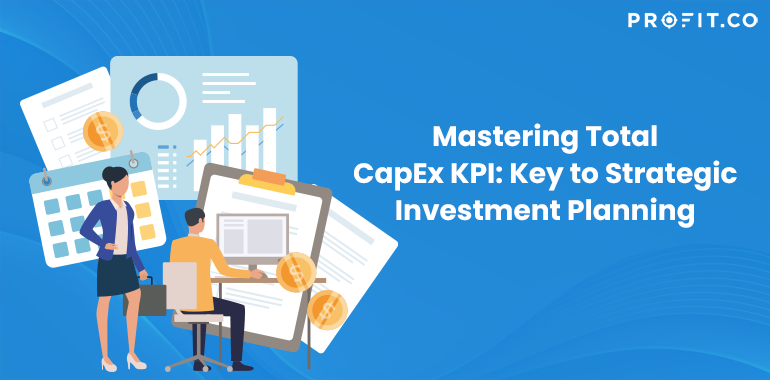The Role of Total CapEx in IT Strategy
The monitoring of Total CapEx is crucial for strategic planning in IT. It involves the initial purchase of hardware or software, investments in new technologies, upgrades to existing systems, and maintenance costs. Effective management of Total CapEx ensures that IT infrastructure aligns with the overall business strategy and objectives.
Ready to start your KPI journey today?
There are two primary methods for calculating Total CapEx
Direct Method
- This method involves simply adding up all the capital expenditures made during a specific period.
- This includes acquiring property, plant, and equipment (PP&E): The cost of land, buildings, machinery, furniture, computers, and other long-term assets.
- Capital improvements: This includes the cost of significant upgrades or renovations to existing PP&E.
- Capitalized research and development (R&D): This includes the cost of research and development activities expected to generate future benefits for the company.
Here’s the formula for the Direct Method:

Indirect Method:
This method starts with the net change in PP&E and then adds depreciation expense for the period. The logic here is that depreciation represents the portion of the cost of PP&E that has been used up in the current period and, therefore, needs to be added back to get the total amount of capital expenditures made.
Here’s the formula for the Indirect Method:

There are two primary methods for calculating Total CapExChoosing the Right Method
Both methods are valid for calculating Total CapEx, and the choice depends on which method is more efficient and readily supported by your accounting system. The Direct Method is more straightforward, while the Indirect Method can be easier if you already have the net change in PP&E readily available.
“If I was down to the last dollar of my marketing budget, I would spend it on public relations.”
Integrating Total CapEx with OKRs
Objectives and Key Results (OKRs) is a goal-setting framework used by organizations to define and track objectives and their outcomes. Integrating Total CapEx with OKRs involves setting clear objectives related to IT spending and defining measurable key results.
Example of an OKR for Total CapEx in IT
Objective: Optimize IT Infrastructure for Enhanced Efficiency
KR 1: Reduce Total CapEx in IT by 10%
- Review current IT assets for optimization or elimination.
- Negotiate for better rates with IT vendors.
- Implement green computing solutions to cut costs.
KR 2: Decrease Hardware Investment Costs by 15% via Cloud Solutions
- Transition key services to cloud platforms.
- Focus on developing cloud-optimized applications.
- Evaluate multiple cloud providers for cost-effective solutions.
KR 3: Increase IT Asset Utilization by 20%
- Strategically redistribute IT resources for maximum efficiency.
- Implement tools to monitor and optimize asset use
- Conduct periodic reviews to ensure efficient asset utilization
Key Performance Indicators (KPIs) as Key Results
KPIs can effectively serve as Key Results in an OKR framework. Organizations can make more data-driven decisions by quantifying goals like Total CapEx reduction. KPIs, as KRs, ensure that objectives are measurable and trackable.
Common FAQs about Total CapEx and OKRs
1. How Can OKRs Help in Managing Total CapEx in IT?
OKRs facilitate focused goal-setting and tracking, helping IT departments prioritize investments and measure the impact of their CapEx decisions against the organization’s strategic objectives.
2. Can Total CapEx Reduction Impact IT Performance?
While reducing Total CapEx is a common objective, balancing cost-cutting with the need to maintain effective IT operations is crucial. Strategic reductions, rather than blanket cuts, are key.
3. How Often Should Total CapEx KPIs Be Reviewed?
Total CapEx KPIs should be reviewed regularly, typically every quarter, to ensure alignment with the organization’s objectives and market dynamics.
4. Are There Risks Associated with High IT CapEx?
High IT CapEx can strain an organization’s financial resources, especially if it does not translate into proportional value generation. It’s important to ensure that CapEx aligns with long-term strategic goals.
5. How Can Small Businesses Manage Total CapEx Effectively?
Small businesses can manage Total CapEx by prioritizing essential investments, exploring cost-effective alternatives like cloud services, and regularly reviewing their IT spending in relation to their business growth and needs.
Conclusion
Total CapEx as an IT KPI, when effectively integrated into an organization’s OKRs, can significantly contribute to strategic IT management and overall business success. By setting clear objectives and measurable key results, organizations can ensure their IT investments are both cost-effective and aligned with broader business goals. Regular review and adjustment of these OKRs in response to technological advancements and market changes can further enhance this strategic alignment.

